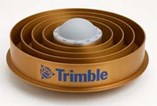Trimble Introduces GNSS Choke Ring Antenna For Multipath Mitigation

Sunnyvale, CA - Trimble recently introduced the Trimble GNSS Choke Ring geodetic antenna as part of its network infrastructure portfolio.  The traditional choke ring's ground plane has been widely adopted by the scientific community due to its effectiveness in reducing the strength of multipath signals before they enter the receiving element. Trimble has further updated the antenna electronics to improve low-noise amplification and Global Navigation Satellite System (GNSS) tracking. The advanced Trimble GNSS Choke Ring antenna tracks all existing and planned GNSS constellations.
The traditional choke ring's ground plane has been widely adopted by the scientific community due to its effectiveness in reducing the strength of multipath signals before they enter the receiving element. Trimble has further updated the antenna electronics to improve low-noise amplification and Global Navigation Satellite System (GNSS) tracking. The advanced Trimble GNSS Choke Ring antenna tracks all existing and planned GNSS constellations.
When multipath signals are present, Trimble's geodetic antennas use advanced technology to reduce the effects of the signals. The extended ground plane of Trimble's geodetic antennas impedes multipath signals that reflect off of surfaces below the antenna from entering the receiving element. The scientific standard Jet Propulsion Laboratories' (JPL) choke ring design combined with a Trimble-exclusive Dorne & Margolin dipole element, reflect these signals away from the antenna. This mechanical multipath mitigation technique differs from Trimble's Zephyr Geodetic antenna with Trimble Stealth technology. Its ground plane design consumes multipath signals and turns them into harmless heat. With both antennas, Trimble's innovative design and technology provides successful multipath mitigation and superior positioning performance.
"The Trimble GNSS Choke Ring antenna represents Trimble's commitment to providing customers with the highest quality solutions on the market, either via the traditional JPL choke ring mechanical design or with the innovative stealth technology," said Pierre Desjardins, business manager for Trimble's GNSS Infrastructure business area. "Our GNSS geodetic antennas offer superior accuracy and exceptional performance for RTK networks and scientific applications. The customer can now choose which antenna best suits their needs."
In addition to the new choke ring antenna, Trimble also offers the Zephyr Geodetic 2 antenna which provides an alternate means to achieving geodetic-quality results. It delivers frequency-independent multipath mitigation and its small, lightweight design with built-in radome allows the antenna to be mounted on lighter structures. In addition, the Trimble Zephyr Geodetic 2 antenna's low-profile provides greater stability from reduced wind resistance.
SOURCE: Trimble
